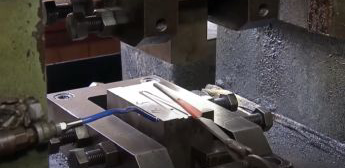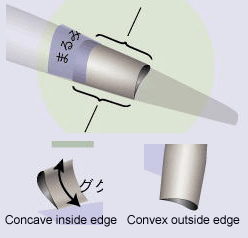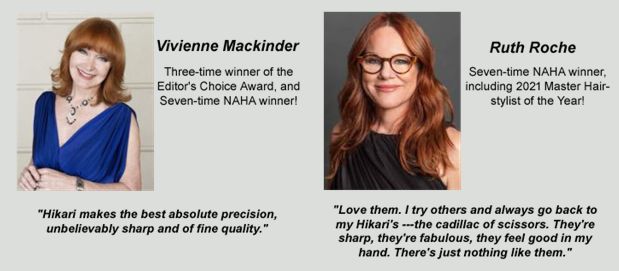
Craftsmanship & Quality vs Metal Specifications!!! We Have the Answers to Your Questions.
All Hikari scissors are comprised of a proprietary blend of molybdenum, cobalt, vanadium and various other alloys. Because we have been making scissors for over 50 years, we have been able to experiment with many different percentages. We have found the percentages that give the best sharpness, durability, strength, hardness, and ductility (the degree in which a steel can flex or bend without fracturing, very important when balancing a scissor). All of these factors affect the way a scissor feels as it cuts through the hair as well as the long term performance.

The method of tempering the steel and the Rockwell hardness are also factors that affect the performance of the scissor. However, without a doubt, the most important ingredient is the quality of craftsmanship that is used to make the scissor. All Hikari scissors are handmade by the highest skilled technicians at the Hikari factory in Japan.
Here is a short video clip of the scissor making process filmed at the Hikari Factory in Japan.
We Have the Answers to Your Questions
Question: Are Hikari scissors forged or cast? Answer: All HIkari scissors are forged.
Fact: Today, almost all high quality scissors are forged.


Casting is the process where metal is heated until molten. While in the molten or liquid state it is poured into a mold or vessel to create a desired shape.
Forging is the application of thermal and mechanical energy to steel billets or ingots to cause the material to change shape while in a solid state.


Question: Is it true that if two different scissors, that are made out of the same material and have the same Rockwell Hardness, they will have the same metal performance?
Answer: No. Even more important than the type of metal that a scissor uses is the how the metal was tempered.
Tempering is a heat treatment technique applied to ferrous alloys, such as steel or cast iron, to achieve greater toughness by decreasing the hardness of the alloy. The reduction in hardness is usually accompanied by an increase in ductility, thereby decreasing the brittleness of the metal. As written on our website, Hikari uses vacuum heat tempered alloys, this process makes the metal very strong and yet somewhat flexible (so it can be set and balanced and the blades will flex across each other). It also gives the feeling that it "cuts like a hot knife through butter" that we have become famous for. The tempering of a material is done in the country that the scissor is made. So if a Korea or China scissor uses Japanese steel, it is Korea or China tempering, not Japanese tempering which is a crucial part of the performance of the steel. So for example, Japanese 440C steel is NOT the same on all scissors, even though it’s technically the same material. Each company has their own unique way of tempering the scissor. That is why scissors from different countries with the same specifications will feel and perform very different.
Question: What is Rockwell Hardness?
Answer: The Rockwell scale is a hardness scale based on indentation hardness of a material. The Rockwell test determines the hardness by measuring the depth of penetration of an indenter under a large load compared to the penetration made by a preload. Basically Rockwell hardness is how hard a material is. So technically, the higher the Rockwell hardness, the harder the metal is.
Important Fact: Harder is not always better!
If the material was a knife, a high Rockwell hardness would result in a knife that is less likely to get a chip or nick in it when cutting a hard material. However, if the Rockwell hardness is too high, the material is brittle and can shatter or break. How high you make the Rockwell hardness will also be determined by the type of metal you use. The lower quality metal you use, the lower the maximum Rockwell hardness you can use without the material becoming too brittle.
Now when it comes to scissors, it's even more complicated. You have two blades rubbing across each other. So if you have two very hard objects rubbing across each other, hundreds of times a day, and both objects are extremely hard, they dull each other very quickly. It's like a diamond rubbing across a diamond. Both are very hard and strong but they are now rubbing against each other. Also, if the blades are too hard, they don't "flex" across each other which is very important when you have convex blades with a concave or hollow grind inside. This "flexing" of the blades across each other is what makes convex scissors cut accurately and cut from the inside out.
Question: What is the difference between convex vs. serrated?
Answer:

Convex - cuts cleanly through the hair with two smooth blades coming across each other.

Serrated - holds the hair like a comb & when it cuts through the hair it can damage the cuticles.
Important Fact: Many scissor manufacturers are now making scissors with a convex edge. But, it isn't just about putting a convex edge on the scissor. The quality of the convex edge plays a big part in the way a scissor performs and feels as it cuts through the hair.
The Hikari precision convex edge combines a hand-buffed outer blade with a hollow ground concave inner blade. Both blades are polished by hand to razor sharpness. This edge has no serrations or conventional outer edge bevel or grind. Hikari's convex edge has a lower angle than other scissors. This lower angle along with the consistency of the angle from tip to pivot make Hikari scissors the most accurate in the world. There is so much that goes into how a scissor performs, the most important ingredient is the craftsmanship. Everything must work together.
Reality Check!
Question: So if the specs don't determine a good scissor, how do you know what to buy?
Answer: The same way you would buy any expensive item like a car. You would go by past performance, reviews, reputation, test drive it, etc.

Would you buy a no name car based on specs? Wow, the specs of the car are great, but the car runs horrible, I don't get it. It's no different with scissors. Ask other experienced stylists what they use and their opinions and go by reputation and try the scissor yourself. Real world performance is what really matters. If the specs are really good, but everybody hates the product, what does it matter? The real proof can be found in the long term performance of the product and the reputation it has earned.
For more than 50 years, Hikari has distinguished itself by consistently producing scissors of extraordinary comfort, precision, performance, and longevity. In response to numerous inquiries from loyal customers around the world, we are honored to share this information with you.